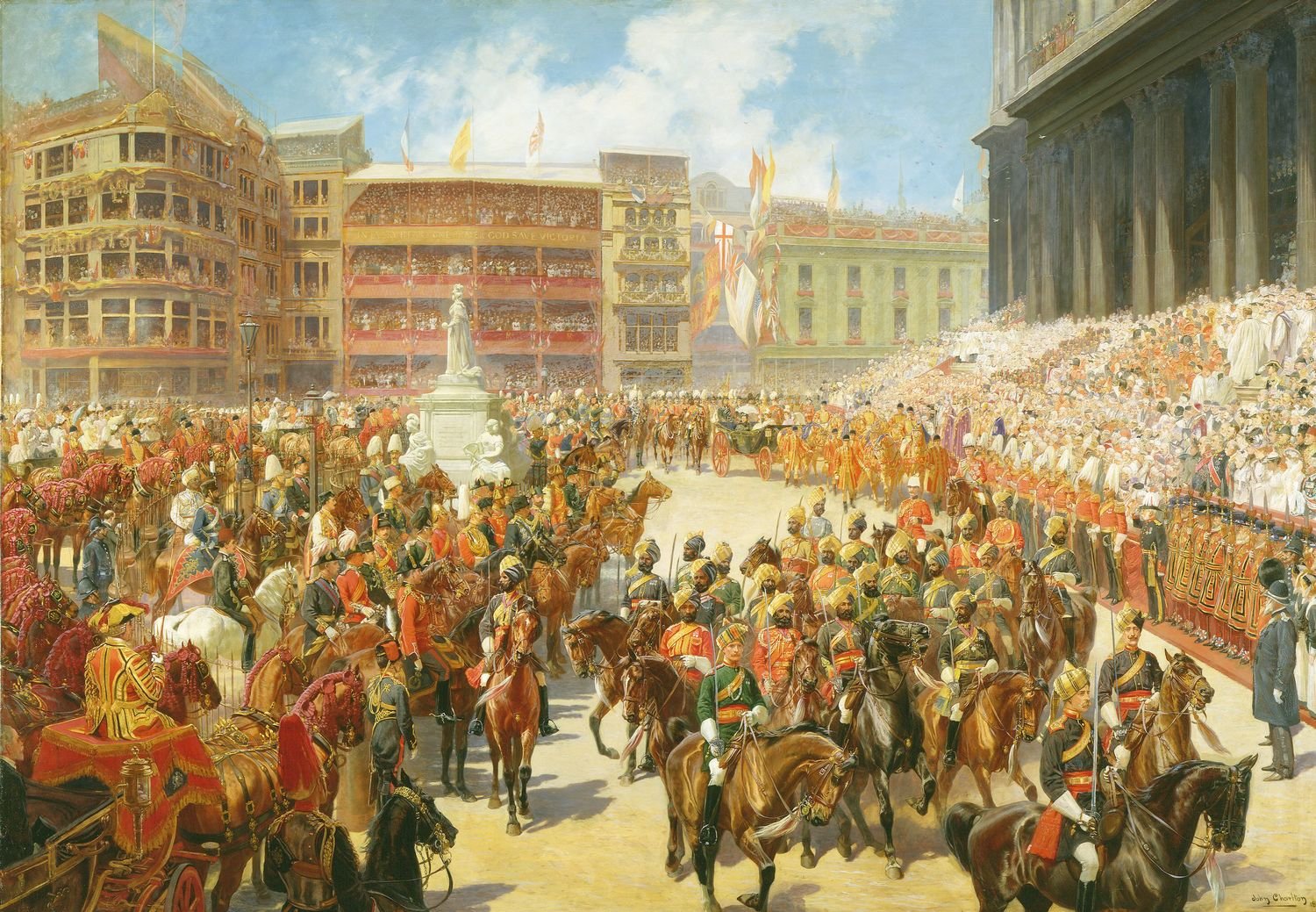
Royal Jubilees
Milestone years have been celebrated in long reigns since George III
ROBERT GLEESON
Queen Victoria's Diamond Jubilee fan
1897RCIN 25065
Queen Victoria’s Diamond Jubilee in 1897 provided the opportunity for British lace-makers to prepare fans for presentation to their Sovereign, rather than to the younger members of her family. This fan was the gift of the Worshipful Company of Fan Makers. Its presentation followed the fourth Competitive Exhibition, held by the Fan Makers under the patronage of Queen Victoria, who had lent four fans to the exhibition from her own collection. It was the first gift of a ‘Royal Presentation’ fan by the Fan Makers Company. Both the lace leaf and the ivory guards and sticks had been awarded prizes at the exhibition: Miss Lizzie Oldroyd, who made the lace leaf, won Mr Duvelleroy’s ‘special prize’, while Robert Gleeson, who signed the front guard, was awarded the prize for fan-mounts. When the proposed gift was first raised with Sir Arthur Bigge (Keeper of the Privy Purse) on 11 June 1897, Mr H.H. Crawford (Chairman of the Fan Makers exhibition committee) was at pains to point out that the fan was entirely the work of British subjects. On 19 June, the day following the delivery of the fan, Sir Arthur wrote on behalf of Queen Victoria to thank the Company for the gift, and to pass on ‘her congratulations upon the artistic talent which in it [Miss Oldroyd and Mr Gleeson] have respectively displayed’.
Miss Lizzie Oldroyd, of Denne Manor, Chilham, Kent, was a lady amateur member of the Fan Makers Company. For this leaf she used the Maltese lace-making technique, combining cream silk with simulated gold thread (consisting of silk thread dyed yellow, wrapped around with yellow-coloured metal strips), and further ornamentation by tiny gold beads and spangles. Maltese lace is a straight bobbin lace made in one continuous process, pattern and ground together. The emblems incorporated into the leaf include the national emblems of the United Kingdom together with a crescent moon and a Maltese cross; the latter would normally suggest that the lace was actually made in Malta, but contemporary records clearly state that Miss Oldroyd produced it in Kent. Lace-making was reintroduced to Malta and Gozo in the 1830s and continues to this day.
Robert Gleeson (who signed the guards) was also a member of the Fan Makers Company and an employee of Messrs Duvelleroy, whose trade stamp appears inside the fan box. He also carved the sticks for Queen Mary’s Coronation Fan. According to the contemporary description in the Daily Graphic, the present fan was ‘rivetted with diamonds, and enclosed in a handsome case with crown and Royal initials in 18-carat gold’. Although the box has survived, the diamond-studded rivets have not.
Signed on the verso R. Gleeson
Text adapted from Unfolding Pictures: Fans in the Royal Collection 2005
Miss Lizzie Oldroyd, of Denne Manor, Chilham, Kent, was a lady amateur member of the Fan Makers Company. For this leaf she used the Maltese lace-making technique, combining cream silk with simulated gold thread (consisting of silk thread dyed yellow, wrapped around with yellow-coloured metal strips), and further ornamentation by tiny gold beads and spangles. Maltese lace is a straight bobbin lace made in one continuous process, pattern and ground together. The emblems incorporated into the leaf include the national emblems of the United Kingdom together with a crescent moon and a Maltese cross; the latter would normally suggest that the lace was actually made in Malta, but contemporary records clearly state that Miss Oldroyd produced it in Kent. Lace-making was reintroduced to Malta and Gozo in the 1830s and continues to this day.
Robert Gleeson (who signed the guards) was also a member of the Fan Makers Company and an employee of Messrs Duvelleroy, whose trade stamp appears inside the fan box. He also carved the sticks for Queen Mary’s Coronation Fan. According to the contemporary description in the Daily Graphic, the present fan was ‘rivetted with diamonds, and enclosed in a handsome case with crown and Royal initials in 18-carat gold’. Although the box has survived, the diamond-studded rivets have not.
Signed on the verso R. Gleeson
Text adapted from Unfolding Pictures: Fans in the Royal Collection 2005







